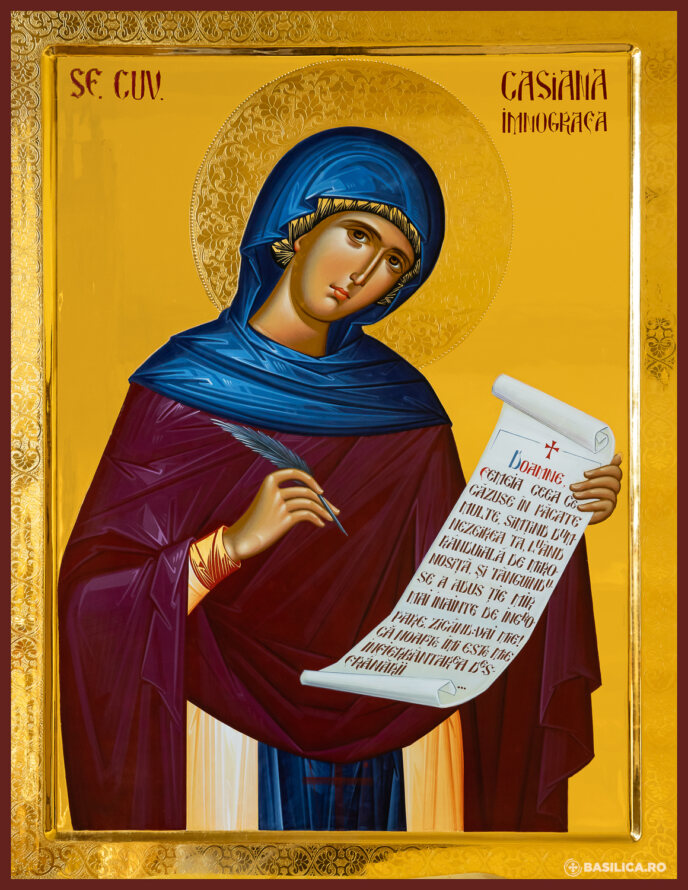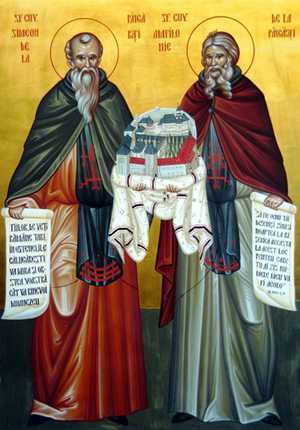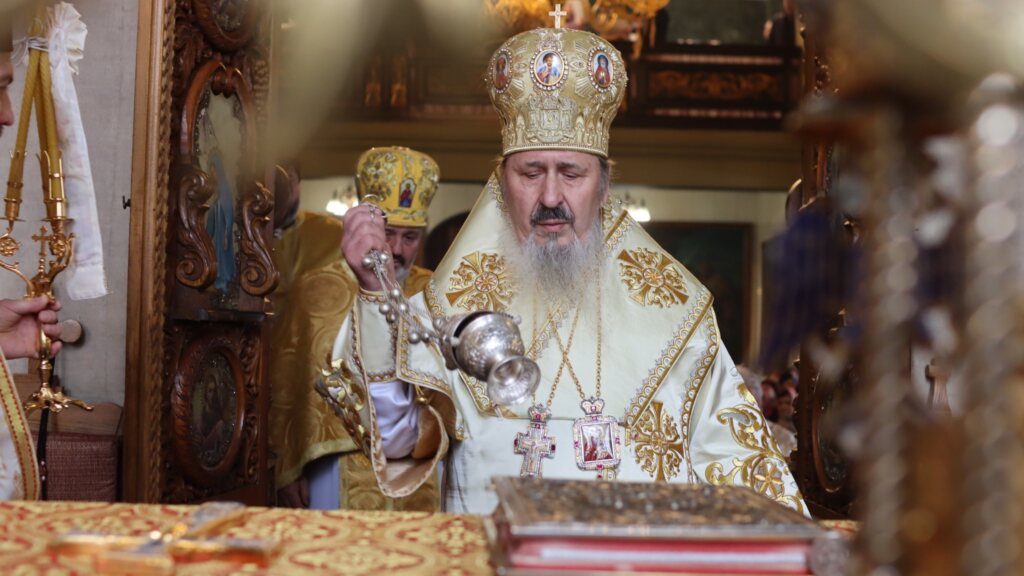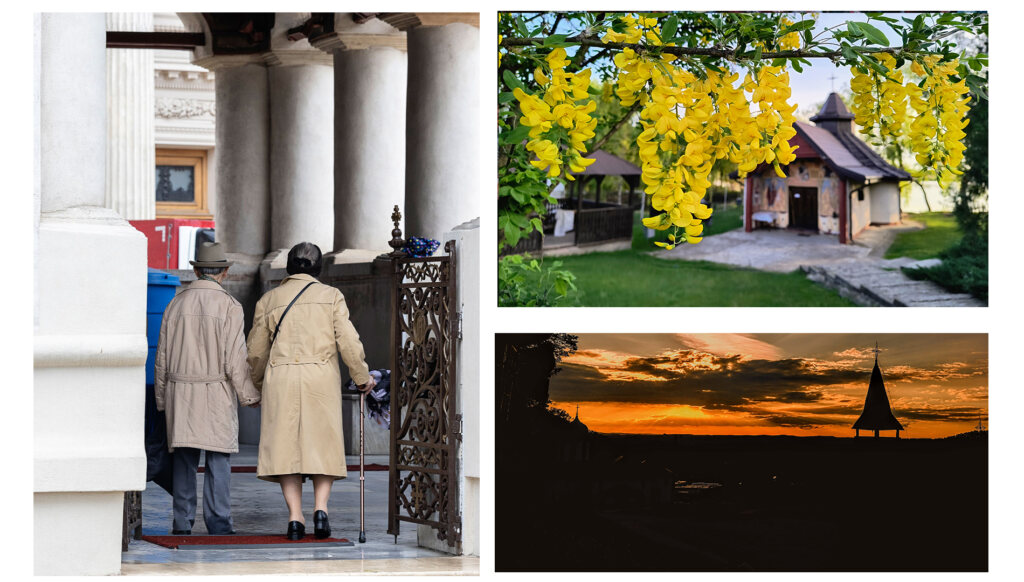Forefeast of the Nativity of the Mother of God
The first lesson at Great Vespers (Genesis 28:10-17) describes Jacob’s dream of a ladder reaching from earth to heaven, and the angels ascending and descending upon it. The second lesson (Ezekiel 43:27-44:4) speaks of the gate of the sanctuary which faces east. God enters through this gate, which is shut so that no one else can enter by it. The third reading (Proverbs 9:1-11) talks about the house that Wisdom has built.
These readings are interpreted as prefiguring the Mother of God.
Martyr Sozon of Cilicia
A native of Lykaonia, was a shepherd. He read the Holy Scriptures attentively, and he loved to share his knowledge about the One God with the shepherds who gathered together with him. He brought many to the faith in Christ and to Baptism.
One night, as he sat under an oak tree, he had a vision foretelling his martyrdom for Christ. He went to the city of Cilician Pompeiopolis, where a festal pagan celebration was being prepared for a golden idol, standing in a pagan temple.
Unseen by anyone, Saint Sozon went into the pagan temple and broke off the idol’s hand, then he smashed it and gave the gold to the poor. The missing hand of the idol caused an uproar and commotion in the city. Many were under suspicion, and were subjected to interrogation and torture.
Not wanting to be the cause of suffering for other people, Saint Sozon went to the emperor Maximian (284-305) and declared that it was he who broke the hand of the idol.
“I did this,” he said, “so that you might see the lack of power of your god, which offered me no resistance. It is not a god, but a deaf and dumb idol. I wanted to smash it all into pieces, so that people would no longer worship the work of men’s hands.”
The emperor in a fitful rage commanded that Saint Sozon be tortured mercilessly. They hung him up and struck him with iron claws, and then they put iron boots in which there were nails on his feet and took him through the city.
After this they again suspended him and beat him with iron rods until his bones broke. In these terrible torments Saint Sozon gave up his spirit to God. By decree of the emperor, slaves lit a fire to burn the body of the martyr, but suddenly lightning flashed, it thundered loudly, and rain poured down over the fire.
Christians took the body of the martyr by night and buried it. By his grave and at the place where he had the vision, many of the sick were healed. A church was built later in memory of the sufferings of the holy martyr.
Troparion — Tone 4
O Martyr Sozon, you pledged your life to God, / Enduring the contest and becoming a sharer in Christ’s passion. / Save from temptation those who cry to you: / “Glory to him who strengthened you! / Glory to him who crowned you! / Glory to him who through you works healing for all!”
† Ven. Simeon and Amphilochius of Pângăraţi
Pious Simeon was born at the beginning of the 15th century in a village close to Piatra Neamţ city, at the time of the pious ruler prince Alexander the Kind (1400-1432). From his youth, he was a very religious man, choosing to live monastic life and joining the community of Bistriţa Monastery.
After much ascetic practice and obedience, in 1432, he retired together with two of his disciples on the left bank of Pângăraţi creek. There, he built a cell of fir beams in a beautiful meadow, where he stayed together with his disciples in permanent prayers, so that his place was known as “Simeon’s Hermitage”.
Having heard of him, Right-believing Ruler Prince Stephan the Great (1457–1504) helped him raise a small wooden church dedicated to Saint Great Martyr Demetrius, the Myrrh Bearer. When metropolitan Teoctist I consecrated it, Venerable Simeon was ordained priest, having become the first founder and igumen of Pângăraţi Monastery, called “Simeon’s Skete” until 1508.
There he gathered many disciples around him, growing in self-denial and prayer and receiving the gifts of healing and of prophecy. The faithful benefited from his blessings, as well as the high officials, and even Right-believing Ruler Prince Stephan the Great, who used to ask for his advice for him and for the country.
In 1476, when the Turks invaded Moldavia and won the battle of Războieni, Venerable Simeon prayed for the country and for the ruling prince to rid them of the invaders, took his disciples and settled at Caşva Monastery, in Mureş region. There, he passed away the same year in the autumn, having been buried in that monastery.
Towards the end of 1484, when peace was reigning again in the country, Right-believing Ruler Prince Stephan the Great put his relics in a shrine and kept them in his treasury, in great honour. Then, he took parts of the relics and put them in a shrine for veneration, burying the rest of them in the Citadel of Suceava.
Venerable Amphilochius from Pângăraţi was born in 1487, in Ţara de Sus, Moldavia. He began his monastic life since his youth, at Moldoviţa Monastery, where from he came to Pângăraţi, in 1508. There, all the members of the community elected him abbot, so that he led them for 56 years.
Hieromonk Anastasios from Moldoviţa, who knew him well, speaks about his life: “He chose to live in monasticism ever since he was a child, having been esteemed by all the people of his time for his good deeds. He was a very good writer, fasting, patient and striving to live a spiritual life”.
Due to his efforts, Christ, our Lord, and Saint Demetrius, the protector of the monastery, made ruler prince Alexandru Lapuşneanu (1552-1561; 1564-1568) build a new church at Pângăraţi, instead of the old wooden one which the Turks had burned down.
The church was consecrated by metropolitan Gregory of Suceava in 1560. In 1566, the Saint gathered all his spiritual sons around, gave them last advice, appointed hieromonk Teodorit as igumen replacing him and retired at his first monastery, Moldoviţa.
There, blessed Amphilochius became a hermit by the name of Enoch and lived for four more years. In 1570, having known before the time of his death, he received the Holy Communion, fell asleep into the Lord, and his disciples buried him.
On 6 March 2008, the Holy Synod of the Romanian Orthodox Church canonised Venerables Simeon and Amphilochius, to be celebrated on 7 September.
Through the prayers of the Pious Saints Simeon and Amphilochius, Lord Jesus Christ, our God, have mercy on us. Amen.
Troparion – Tone 3
Oh, Venerable Fathers Simeon and Amphilochius, the ones who enlightened the Carpathian woods through your prayers and filled the whole valley of Bistrița with spiritual scent, close advisers of the ruler princes and radiant torches of the monastics and of the pious faithful, pray to God for us, who celebrate with love your holy commemoration.
Saint Cassiani the Hymnographer
Saint Cassiani is a well-known Byzantine poet who lived during the reign of Emperor Theophilos (829 – 842).
She was tonsured about the year 820, and founded a convent on Xerolophos, one of Constantinople’s seven hills. There (according to the monk George the Sinful) she led “an ascetic and philosophical life” which was pleasing to God. She was an energetic Igoumeness who not only regulated the life of the convent, but also found time to pursue her literary interests. She combined the talents of poet, theologian and musician, writing hymns and composing musical settings for them. Originally sung by her nuns, many of her compositions have enduring value. At least twenty-three of her hymns were later included in the Church’s liturgical books.
One of Saint Cassiani’s most famous hymns is sung during Matins on Holy Wednesday, on the subject of the woman who had fallen into many sins, which is based on Saint Luke’s Gospel (7:36-50).
Another of her hymns is sung in the Canon of Matins for Holy Saturday, and is repeated at the Midnight Office on Holy Pascha: “Do not weep for me, O Mother, beholding in the tomb the Son Whom thou hast conceived without seed in thy womb, for I shall arise. . .”
Saint Cassianḗ is not mentioned in the Synaxaristés, yet the inhabitants of Kasos, because of the similarity of her name with that of their island, celebrate her Feast Day on September 7. A special Church Service was composed in her honor, and it was published in Alexandria in 1889 by the “Reformed” (or “Reorganized”) printing house.
It is strange, however, that this Service was dedicated to Patriarch Sophronios of Alexandria, who in turn gave it to Metropolitan Germanós of Thebes to be printed (on September 1, 1889). Thus, Cassianḗ’s glorification by the Church of Alexandria was somehow formalized, as the inhabitants of Kasos desired.
For centuries Saint Cassiani’s name has appeared at the end of all the lists of Byzantine poets. The first known list was compiled by Nikēphóros Kállistos Xanthopoulos in the first half of the XIV century.
Saint Cassiani is depicted among the holy ascetics and other monastics in the icon for the Triumph of Orthodoxy on the first Sunday of Lent.







